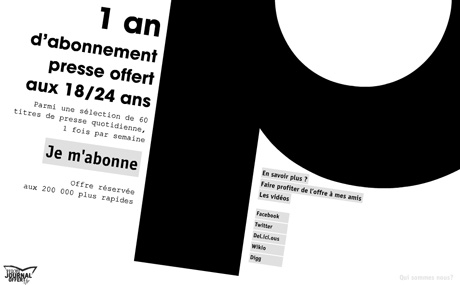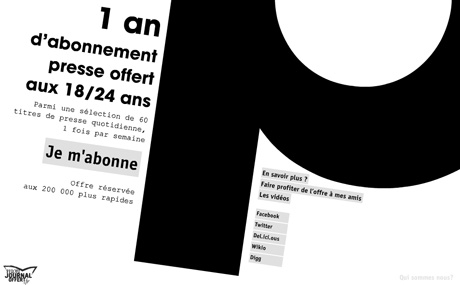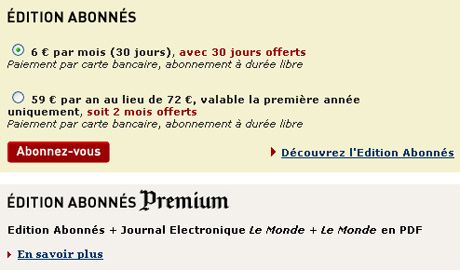Crea Digital Day 2017
The 8th edition of the Crea Digital Day took place yesterday at Unimail Geneva. From 8:30 to 17pm, 13 conferences [...]

« Radio, what’s new / Radio, someone still loves you« , sang the famous rock-band Queen in their hommage to radio, by this time when TV was becoming more and more important in our lives. Well, today, we could sing the same old song about newspapers. There seems to be a common theory, according to which the Generation Y, born with the Internet, won’t buy newspapers anymore. Boring and unpractical, newspapers? Well, it quite looks like these theories were wrong. An initiative from the French newspapers has reached its 200 000 readers quota, which is quite a lot knowing that the operation started on… the 27th October! Want to know more about this good move?

Screen capture of « Mon journal offert » website homepage.
Mon journal offert operation was born during the French Newspapers Estates General, in January 2009, and impulsed by the Ministry of Culture. Regarding the press financial issues all over the world, the French government was looking for a program to develop this sector. And « My free newspaper » was one of the selected ideas. The concept is that every young adult between 18 and 24 years old could be granted a free newspaper, one issue by week for one whole year. Of course, the goal was to reach this Generation Y who spends so much time on Internet, including for her information, and can’t imagine living without the Net (nor how her parents could ever have lived without it).
Only a few days after the operation started, it exceeded everyone’s expectations! Whereas the program was supposed to last one whole year, until October 2010, it had already almost reached the 200 000 quota at the beginning of November. Speaking in conversion terms, that means a 150 000 conversion in less than one week! Exactly, 150 000 subscriptions have been made between the 30th October and the 3rd November. Based on the French 5 million 18-24 population, we are talking about a 3% conversion (and that’s unqualified population).
A few figures:
1. Highly interesting program for the prospects. First of all, of course, it is a very interesting operation. Adults between 18 and 24 years old, specifically those who study in a University, can be expected to be interested by this kind of operation. But this is not the only reason, as students already benefit from very profitable offers to suscribe to newspapers. We have to dig deeper.
2. Strong communication plan. Of course, newspapers can easily communicate and reach an important part of the population. The communication plan promoting My free newspaper appeared in each participating news title, and on their website. The government also made sure to place the campaign on 18-24’s favorite websites. But as the campaign only started on the 30th October, it can’t really be associated to this very reactive success, or at least can’t be used to explain it all. Moreover, the campaign videos haven’t been seen a lot on Youtube (the two got a total of 227 views). The campaign itself didn’t have so much of a success, despite the videos quality.
One of the 2 videos of the campaign: « See, you like reading a newspaper… Then go on! ».
So these 2 obvious reasons can’t explain the operation impressive success. But then, what can?
3. Removing major obstacle: the cost. Why do only 10% of the 10-24 population read newspapers (2007 figures)? I think this operation unveiled a theory papers have been hiding for a while. The major point of the program is that it removed all obstacles related to the price of the subscription. The consequence is that this operation was able to reach a huge population, compared to major newspapers’ audience! (As a reference, please consider 300 000 issues of Le Monde are printed each day.) I think there really is something to think about here: remove, or lower, the cost obstacle, and you’ll probably find young adults actually are interested by newspapers.
4. Making the subscription simpler. Don’t ask me why, but subscribing to a newspaper in France has become very complicated. First, offers are written like « xx$ per month (30 days) and 30 days free », or « xx$ per month instead of yy$ the first year, equivalent to 2 months free ». Then, the costs vary according to the period you choose to subscribe for, just like a cellular: « 1 month for xx$, 2 months for yy$, …, 2 years for zz$ ». And all this is added to the many offers combinations. I have a feeling readers get lost. During My free newspaper operation, no need to study the costs tables: you just give your address and receive your paper.

First step of Le Monde’s subscription process.
5. Giving newspapers a new aura of popularity. During recent years, news about newspapers have almost been all about losses, financial issues, problems, and more negative stuff. It all contributed to give newspapers a bad image, and helped wrong ideas grow up, like:
This operation gave a new positive window for newspapers. For once, they weren’t placed in the financial column, but had a huge space in a very positive project. Despite issues and audience losses, newspapers have built themselves a new and positive opportunity to communicate. And this opportunity is particularly adapted to the young adults, an audience it was vital for them to reconquer. The distribution of the subscriptions among the newspapers showed that they still have a good image, like Le Monde, Le Figaro, or even L’Équipe: young adults not only know them, but are ready to subscribe to them, as long as you get read of the cost and subscription obstacles.
My free newspaper has reached a major success, which could be an inspiration for the future of the printed news world. When everybody is saying Internet is the next challenge for information, this success shows the newspapers are not done, and even far from there. This program can be seen as an experiment, which concludes the cost and subscription process are two variables news groups could work on to increase their readers, at least among the 18-24 population, this famous Generation Y. « Someone still loves you…« : newspapers haven’t said their last word!
Now, what do you think about this project? Would it have worked the same way in your country? Don’t hesitate to give your opinion and start the debate!
Based on « L’opération de promotion de la presse écrite auprès des jeunes connaît un vif succès » by Le Monde.fr
